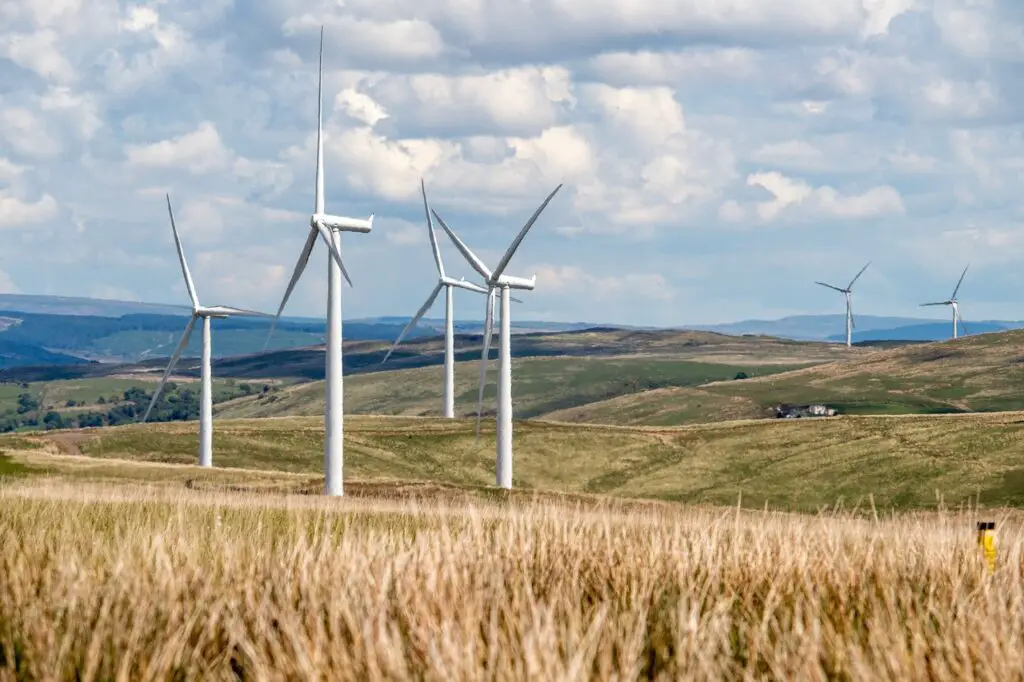Wind turbines are a key component of the renewable energy sector, harnessing the power of the wind to generate electricity without burning fossil fuels.
Wind turbines are large mechanical devices that generate electricity by harnessing the power of the wind. They consist of a tower, a rotor with blades, and a generator that converts the mechanical energy of the spinning blades into electricity.
Wind turbines generate electricity in various settings, including onshore and offshore, and they are an important renewable energy source.
Renewable energy sources do not produce greenhouse gases or other pollutants, making them a cleaner and more sustainable alternative to fossil fuels like coal, oil, and natural gas.
Wind turbines are one of several types of renewable energy technology, along with solar panels, hydropower, and geothermal energy. The use of renewable energy is growing globally as countries and businesses seek to reduce their reliance on fossil fuels and mitigate the impacts of climate change.
Wind energy is particularly attractive because it is a relatively low-cost and low-carbon form of electricity generation, and wind resources are widely available in many parts of the world.
The deployment of wind turbines has grown significantly in recent years, and they now contribute a significant portion of the world’s total electricity generation.
The misconception that coal is used to make wind turbines
There is a common misconception that coal is used to make wind turbines. This idea may be based on the fact that many wind turbines are made from steel, a material often produced using coal.
However, it is important to note that steel is just one of several materials used in constructing wind turbines. It is not the primary material used in the blades or other critical components.
Wind turbines are made from various materials, including composite materials, metals, and plastics.
The blades of a wind turbine, the most visible part of the device, are typically made from composite materials such as fiberglass, carbon fiber, or a combination of both. These materials are lightweight, strong, and durable, making them well-suited for use in wind turbine blades.
While it is true that coal is used in producing steel and other materials used in wind turbines, it is not a primary component of wind turbines.
The energy inputs for wind turbine production come from various sources, including electricity, natural gas, and renewable energy.
The environmental impacts of wind turbine production are generally much lower than those of other forms of electricity generation.
Energy inputs for wind turbine production
The production of wind turbines involves the use of a variety of energy inputs, including electricity and fossil fuels. Electricity is used to power the manufacturing equipment and facilities used to produce wind turbines.
This includes the machines used to fabricate and assemble the various components of the wind turbine and the lighting and heating systems used in the manufacturing facility.
Fossil fuels, such as oil and natural gas, may also be used as an energy input in the production of wind turbines. These fuels may be used to generate electricity for the manufacturing process, or they may be used directly as a source of heat or power for certain manufacturing operations.
In addition to electricity and fossil fuels, other energy inputs that may be used in the production of wind turbines include water, steam, and compressed air, which are used to power various machines and equipment in the manufacturing process.
Overall, the energy inputs required for wind turbine production can vary depending on the manufacturing process and technologies used.
Some manufacturers may strive to minimize their energy use and emissions by implementing energy-efficient technologies and practices, while others may rely more heavily on traditional energy sources.
Environmental impact of coal usage in wind turbine production
Coal is a fossil fuel extracted from the ground and burned to generate electricity.
Coal extraction and combustion have several negative environmental consequences, including air pollution, water pollution, and greenhouse gas emissions.
Air pollution
The burning of coal releases several air pollutants, including sulfur dioxide, nitrogen oxides, and particulate matter, which can have negative impacts on human health and the environment.
These pollutants can contribute to respiratory problems, heart disease, and other health problems.
Water pollution
The mining and processing of coal can also pollute water sources, including rivers, streams, and groundwater.
The runoff from coal mines can contain heavy metals and other toxic substances, which can negatively impact aquatic ecosystems and drinking water quality.
Greenhouse gas emissions
Coal is also a major source of greenhouse gas emissions contributing to climate change.
When coal is burned, it releases large amounts of carbon dioxide, a greenhouse gas that traps heat in the Earth’s atmosphere and contributes to global warming.
While the use of coal in wind turbine production may be limited, any coal usage can contribute to these negative environmental impacts.
In contrast, wind energy is a clean, renewable energy source that does not produce air pollution or greenhouse gas emissions.
As such, using wind turbines can help reduce reliance on fossil fuels like coal and mitigate their negative environmental impacts.
Conclusion
Coal is not typically used to make wind turbines. While coal is a fossil fuel that is often used as an energy input in various manufacturing processes, it is not a common energy source for the production of wind turbines.
Instead, wind turbine manufacturers typically rely on electricity and other energy sources, such as oil and natural gas, to power the machines and facilities used in the manufacturing process.
While some wind turbine manufacturers may use coal as an energy input in certain parts of their operations, it is not a primary energy source for the production of wind turbines.







